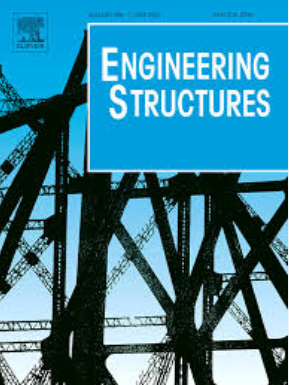自定心支撑钢框架循环性能及破坏机理试验研究
IF 5.6
1区 工程技术
Q1 ENGINEERING, CIVIL
引用次数: 0
摘要
本文对1/2比例尺、3层、1舱自定心支撑框架(SBF)在准静态循环荷载作用下进行了试验研究。介绍了自定心支撑从激活到破坏的工作机理。对SBF的抗震性能、损伤发展和破坏模式进行了研究。分析了内筒屈服和盘形弹簧扁化对SBF抗震性能和SC性能的影响。试验结果表明,尽管柱屈服,但SC支撑内管处于弹性状态时,SC支撑仍能使SBF的剩余层间漂移比保持在修复限值内。只有当SC支撑处于压缩状态时,圆盘弹簧才会变平,这大大增加了支撑的刚度和力。受拉内胎的屈服限制了支撑力的增加,导致SC支撑的残余变形增加和双重激活。SC支撑在内管屈服时表现出不对称的滞后响应。字形支撑模式保证了SBF的高剪力,但也造成了梁的竖向变形和屈服。随着柱和内筒塑性变形的增大,层1框架的滞回响应由旗形变为平行四边形。SC支撑系统是传统支撑系统的替代方案,用于建设弹性城市,因为它具有更低的损坏和残余变形。本文章由计算机程序翻译,如有差异,请以英文原文为准。
Experimental study on cyclic behavior and failure mechanism of self-centering braced steel frame
This paper presents an experimental study of a 1/2-scale, 3-story, 1-bay self-centering braced frame (SBF) under quasi-static cyclic loading. The working mechanism of the self-centering (SC) brace from activation to destruction is described. The seismic performance, damage development, and failure mode of the SBF were investigated. The influence of the inner tube's yielding and the flattening of the disc springs on the SBF's seismic performance and SC behavior was analyzed. The test results indicated that the SC braces maintained the residual story drift ratio of the SBF within the repair limit when the inner tube of the SC brace was in an elastic state despite column yielding. The disc springs flattened only when the SC brace was in compression, substantially increasing the brace's stiffness and force. The yielding of the inner tube in tension limited an increase in the brace force, resulting in increased residual deformation and double activation of the SC brace. The SC brace exhibited an asymmetric hysteretic response when the inner tube yielded. The chevron bracing pattern ensured a high story shear of the SBF but resulted in the beam's vertical deformation and yielding. The hysteretic response of the SBF in Story 1 changed from flag-shaped to parallelogram-shaped with an increase in plastic deformation of the columns and inner tubes. The SC braced system is an alternative to traditional braced systems for building resilient cities because it exhibits lower damage and residual deformation.
求助全文
通过发布文献求助,成功后即可免费获取论文全文。
去求助
来源期刊

Engineering Structures
工程技术-工程:土木
CiteScore
10.20
自引率
14.50%
发文量
1385
审稿时长
67 days
期刊介绍:
Engineering Structures provides a forum for a broad blend of scientific and technical papers to reflect the evolving needs of the structural engineering and structural mechanics communities. Particularly welcome are contributions dealing with applications of structural engineering and mechanics principles in all areas of technology. The journal aspires to a broad and integrated coverage of the effects of dynamic loadings and of the modelling techniques whereby the structural response to these loadings may be computed.
The scope of Engineering Structures encompasses, but is not restricted to, the following areas: infrastructure engineering; earthquake engineering; structure-fluid-soil interaction; wind engineering; fire engineering; blast engineering; structural reliability/stability; life assessment/integrity; structural health monitoring; multi-hazard engineering; structural dynamics; optimization; expert systems; experimental modelling; performance-based design; multiscale analysis; value engineering.
Topics of interest include: tall buildings; innovative structures; environmentally responsive structures; bridges; stadiums; commercial and public buildings; transmission towers; television and telecommunication masts; foldable structures; cooling towers; plates and shells; suspension structures; protective structures; smart structures; nuclear reactors; dams; pressure vessels; pipelines; tunnels.
Engineering Structures also publishes review articles, short communications and discussions, book reviews, and a diary on international events related to any aspect of structural engineering.
 求助内容:
求助内容: 应助结果提醒方式:
应助结果提醒方式:


